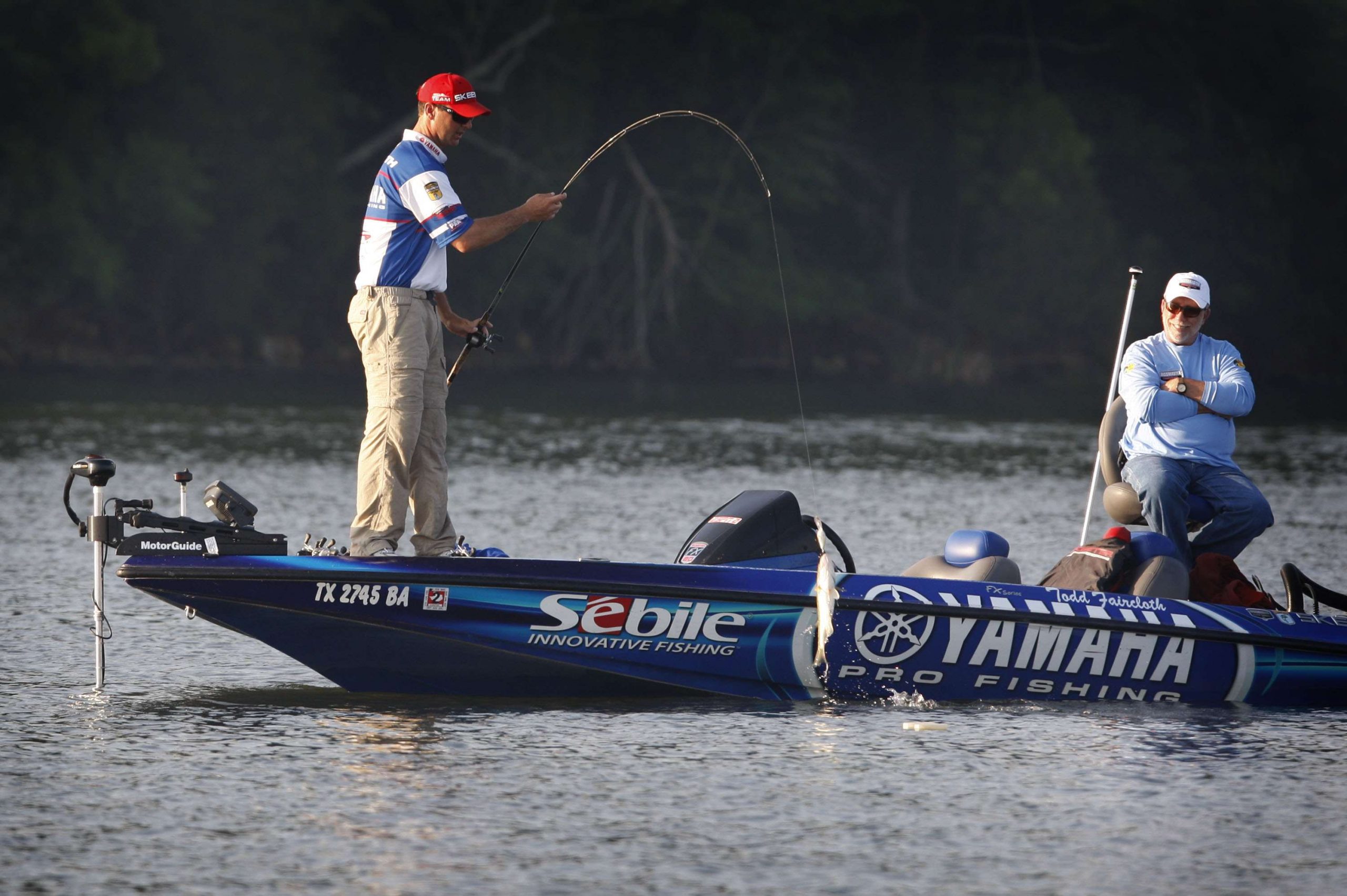
Summer’s winding down, the kids are back in school and the bass on your favorite lake or river have seen it all by now. They know the SKUs of every crankbait and plastic worm in your tacklebox and, if you must know, they’re starting to chuckle to themselves about you’re fishing. Your catch rate probably shows it, too.
Now’s the perfect time to change gears, to zig instead of zag and to breathe some much needed life into your bass tactics. These three Elite pros and Classic qualifiers have just what the doctor ordered.
Todd Faircloth does a 180
Todd Faircloth is a 14-time Bassmaster Classic qualifier, five-time B.A.S.S. winner and one of the best sticks on the planet. When the summertime fishing gets tough for him, he looks for that special change that will make a difference.
“I’ve got a couple of special patterns I like in the late summer that focus on doing things just a little bit differently,” Faircloth explains. “Sometimes that can make all the difference in your catch.”
For deep water bass holding on ledges, Faircloth’s approach is 180 degrees different from most.
“I’ve noticed that 90 percent of the time anglers will put their boat in deep water and cast toward the shallows when they’re fishing a ledge or point,” he says. “Generally, there’s nothing wrong with that, but if the bass are finicky, I’ll do just the opposite.
“By putting my boat in shallower water and casting to deeper water, I not only give the fish a different look, but it’s also going to keep my baits in contact with the bottom more of the time. My favorite bait for this technique is a 3/4-ounce All-Terrain Football Head Jig with a Gary Yamamoto Custom Baits twin-tail trailer. I really like green pumpkin for this tactic.”
Faircloth is a Texan, and many of his favorite local waters (like Sam Rayburn Reservoir) are home to peppergrass. This vegetation can get thick in the summer and will mat on the surface. While other anglers are targeting the more popular hydrilla, Faircloth looks for peppergrass.
“Peppergrass grows on a nice hard bottom and provides a lot of good cover,” Faircloth says. “I like to focus on flats, point and drains with peppergrass that are out on the main lake. I’ll usually throw a buzz frog or hollow-bodied frog and mix it up until I find the type that’s most productive.
“You won’t get a lot of bites doing this,” he warns, “but it’s a great pattern for quality bass — what I like to call ‘tournament fish.'”
Jared Lintner can’t get shallow enough!
 Way out west, in California, where five-time Classic qualifier Jared Lintner lives, late summer is a welcome time of year.
Way out west, in California, where five-time Classic qualifier Jared Lintner lives, late summer is a welcome time of year.
“This is absolutely the best time of year to get as shallow as you possibly can,” says the affable pro. “Even on waters like Clear Lake, where the water really can be extremely clear, fishing in the extreme shallows can be fantastic.”
One reason Lintner likes going shallow at this time is that the rest of his competition — whether he’s in a tournament or just out for a fun day on the lake — is out deep, fishing humps, ledges and points. He prefers to head the other way.
“Going really shallow isn’t necessarily a great bet for getting lots of bites or catching lots of fish,” he warns, “but if you’re looking for five to eight bites from some really nice fish, shallow is the way to go now. You just have to dedicate your day to it.”
Lintner employs a three-pronged approach to his skinny water summer bassin’ — flippin’, buzzing and waking.
“Where you have some cover that will position the bass for you, it’s tough to beat flippin’ and pitching a soft plastic bait like a Chigger Craw or the new Berkley Havoc Pit Boss. I like baits with plenty of appendages and lots of flapping action. I think the bass are targeting bluegill at this time of year, and that flapping action really seems to turn them on. It creates a reaction bite.”
When he wants to cover a little more water, Lintner picks up a buzzbait, like the 3/8-ounce Boogerman or Omega Baits Alpha Shad.
“I cast the buzzbait to cover and vary my speed until I find out what they want. One of the things I really like about the Alpha Shad is that it works well at any retrieve speed. It’s got double blades that allow you to work it fast or just crawl it across the surface.”
If there’s not a lot of cover where he’s fishing, Lintner mixes in a big wakebait, like the 6.4-inch Jackall Mikey.
Once the water temperature starts to fall just a little is when I like the wakebait,” he says. “You’ll find some big bass in the shallows that just love a big meal like that.”
Marty Robinson goes vertical
 Elite pro and three-time Classic qualifier Marty Robinson of South Carolina has a different favorite late summer tactic than those of Faircloth and Lintner in several ways and should prove productive on heavily pressured waters that require a finesse approach.
Elite pro and three-time Classic qualifier Marty Robinson of South Carolina has a different favorite late summer tactic than those of Faircloth and Lintner in several ways and should prove productive on heavily pressured waters that require a finesse approach.
“The later you get in the summer — especially with clear, falling water — the more bass start to suspend,” Robinson explains. “That’s when I like to concentrate on vertical structure like tall brushpiles or concrete pilings.”
Because the water can be very clear — but the fish he catches are often very big — Robinson downsizes his tackle … a little.
“Since these fish can be wary, but most of their food at this time of year is pretty big, I like a Spot Remover Magnum jighead in the 1/4-ounce size from Buckeye Lures. It’s a finesse product, but carries a 6/0 hook and is just right for the bait I like with this rig.
Robinson’s lure of choice is a Zoom Magnum Trick Worm, a bigger, bulkier version of their classic bait.
“It’s just right for this technique,” Robinson says. “I throw it on spinning gear — a Revo Premier reel and 7-foot, medium action Castaway Skeleton rod with 10-pound test Berkley 100% Fluorocarbon line.”
The key to making this pattern work, according to Robinson, is zeroing in on the proper depth. For that, he keeps a close eye on his electronics and carefully monitors the zone from which he’s getting strikes.
“I get a lot of strikes on the initial fall,” he says. “And since the fish are suspended, you’ll want to count your bait to the proper depth before you start a swimming retrieve. Too shallow or too deep, and you won’t get bit.”





